Resilience Through Art: Harmonic Hands for Change
Resilience Through Art was a 2024 artist residency embodying the intersectionality of art, climate resilience, and social justice, showcasing creativity as a powerful catalyst to foster human connection and change.
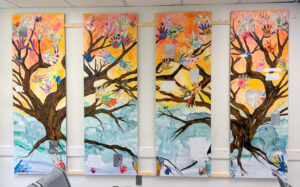
Led by local artist Dinah Myers Schroeder, this project brought together staff and clients of Montgomery County’s Department of Health and Human Services (HHS) to create Harmonic Hands for Change, a vibrant mural symbolizing hope, healing, and our collective responsibility to the environment and one another. Supported through a partnership between Montgomery County’s Department of Environmental Protection (DEP), HHS, and the Arts and Humanities Council of Montgomery County (AHCMC), this residency and the resulting mural emerged as a transformative experience bridging government initiatives, artistic expression, and community healing.
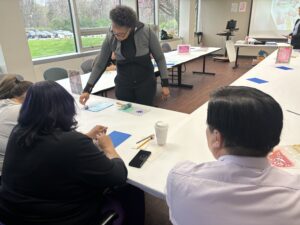 Through an intimate and courageous artistic process, the Resilience Through Art residency explored intersectionality, vulnerability, healing, and collective strength. Artist Dinah Myers Schroeder cultivated a safe, judgment-free space for participants to share personal stories, revealing how climate change and social challenges deeply impact vulnerable communities. Her own experiences of childhood homelessness infused this process with authentic empathy, encouraging others to speak their truths and incorporate their voices into the final mural project.
Through an intimate and courageous artistic process, the Resilience Through Art residency explored intersectionality, vulnerability, healing, and collective strength. Artist Dinah Myers Schroeder cultivated a safe, judgment-free space for participants to share personal stories, revealing how climate change and social challenges deeply impact vulnerable communities. Her own experiences of childhood homelessness infused this process with authentic empathy, encouraging others to speak their truths and incorporate their voices into the final mural project.
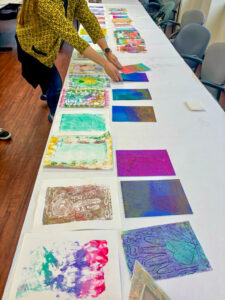 The collaboration between DEP, HHS, and AHCMC represented a uniquely humanistic approach to addressing a complex societal issue. As Doug Weisburger, Senior Planning Specialist, Sustainability Programs with the DEP noted, this residency went beyond traditional climate action strategies; it recognized that meaningful change happens when we humanize data and connect through emotional storytelling. Elbereth Lunn, a lead social worker with HHS, saw the project as an opportunity to transform sterile government spaces into platforms of connection, trust, and hope. The resulting mural became a testament to community resilience—a visual narrative challenging viewers to see beyond statistics, recognize the human experiences behind climate vulnerability, and enact change.
The collaboration between DEP, HHS, and AHCMC represented a uniquely humanistic approach to addressing a complex societal issue. As Doug Weisburger, Senior Planning Specialist, Sustainability Programs with the DEP noted, this residency went beyond traditional climate action strategies; it recognized that meaningful change happens when we humanize data and connect through emotional storytelling. Elbereth Lunn, a lead social worker with HHS, saw the project as an opportunity to transform sterile government spaces into platforms of connection, trust, and hope. The resulting mural became a testament to community resilience—a visual narrative challenging viewers to see beyond statistics, recognize the human experiences behind climate vulnerability, and enact change.
This innovative residency demonstrates the profound potential of creative practices to address social challenges. Harmonic Hands for Change offers a blueprint for compassionate, intersectional approaches to collective learning, community healing, and climate resilience by centering people, amplifying marginalized voices, and creating spaces of genuine connection.
Get to the heart of this transformative project! Dive into rich, personal interviews with Dinah, Doug and Elbereth below. 👇
Flip Through Behind-The-Scenes Photos! 📸
Hear from the Artist in Residence
and Our Partners
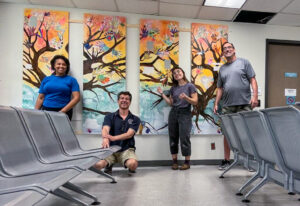
1. Tell us, what was your role in the Artist Residency?
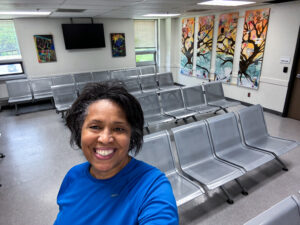
My name is Dinah Myers Schroeder, creator of Another DinahMYTE Creation. I was the Artist-In-Residence for the Department of Health and Human Services in Rockville, Maryland, located at 1301 Picard Drive, in conjunction with the Arts and Humanities Council of Montgomery County. Harmonic Hands of Change was and is an incredibly emotional, meaningful, and worthwhile project as an artist, an individual, and to the memory of the little girl inside me that needed someone extending loving hands, judgment-free, in my time of need. I am thankful for the opportunity to work and lead this project and the time I spent listening to the participants who shared their stories and tears right alongside me. I feel incredibly grateful and blessed to be a part of a transformative cathartic community project.
2. Give us a brief summary of your residency experience. What was your greatest challenge and favorite moment?
The residency had many incredible moments. When I break it down into smaller manageable moments, I must say that hearing people’s stories and sharing my own was the most memorable. Reaching someone who needed help but didn’t realize it and getting them to open up and live in the moment was unforgettable.
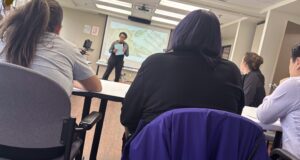 I focused my resident workshops on the homeless community and changing how we see and help people needing support. The unhoused population is the most vulnerable during natural disasters and emergencies affected by climate. This community is usually underserved, and the results of redlining and other systematic factors that have displaced so many people of color and low-income families. Several people shared stories and opened up about things they had never told anyone else. I felt privileged to be a part of their healing journey. When I repeated my story in the second workshop, it felt different from when I told it before. This week, I broke down in uncontrollable tears and took a moment to really live in such a powerful release. It was overwhelming to share this experience of creating a safe space together using art as the catalyst. Art is therapeutic and helps us release the energy we need to let go of to allow growth in our lives. There were multiple moments, and it is hard to pick just one, but this workshop stands out as one of the most memorable.
I focused my resident workshops on the homeless community and changing how we see and help people needing support. The unhoused population is the most vulnerable during natural disasters and emergencies affected by climate. This community is usually underserved, and the results of redlining and other systematic factors that have displaced so many people of color and low-income families. Several people shared stories and opened up about things they had never told anyone else. I felt privileged to be a part of their healing journey. When I repeated my story in the second workshop, it felt different from when I told it before. This week, I broke down in uncontrollable tears and took a moment to really live in such a powerful release. It was overwhelming to share this experience of creating a safe space together using art as the catalyst. Art is therapeutic and helps us release the energy we need to let go of to allow growth in our lives. There were multiple moments, and it is hard to pick just one, but this workshop stands out as one of the most memorable.
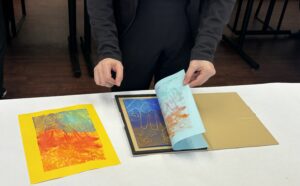 |
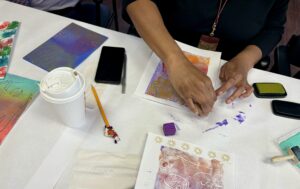 |
When I became a finalist, I interviewed the staff about the community they served. I learned they served a proportionate unhoused community, and I instantly connected. I came from a large family of 14 children with proud parents who worked hard to provide for us but came up short, sometimes leaving us without a home. As a result, we were split up as a family unit. It was devastating to be apart from my family as a child, and I worried about when we would all be together again. Sometimes, we had what we called “air” sandwiches and school lunch was our only meal that day. It didn’t matter how hard they worked to provide for us. We were homeless. I want to change how support for the homeless is requested and provided without judgment. I want to normalize giving and asking for help.
The most challenging part of this project was connecting to climate resilience. I believe homelessness is an emergency that needs changing before the damage of climate change and natural disasters. If I could normalize giving and receiving help, fewer children would be affected when adults are too proud to ask for help at the risk of being judged.
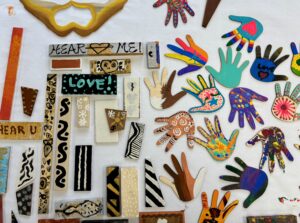
I also enjoyed the sculptural hand workshop. We discussed diversity, equity, and inclusion and how access doesn’t mean equality. Participants worked on individual pieces and then collaborated to create the next step. They were given a little more support and resources with each part of the process, from better materials and supplies to multiple options. Their minds worked together to see what they created with better products and collaboration.
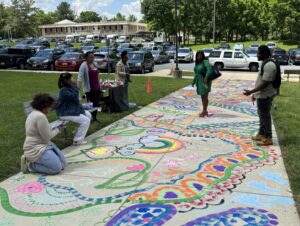 The sidewalk painting workshop was fun and lighthearted. After some heart-wrenching, soul-searching conversations in the weeks before, it was pleasant to go outside and enjoy the fruits of our labor in preparation for welcoming the artwork into the space. The weather was perfect, and we went outside to have some fun. Staff and clientele were invited to drop in and participate in creating beautiful temporary art.
The sidewalk painting workshop was fun and lighthearted. After some heart-wrenching, soul-searching conversations in the weeks before, it was pleasant to go outside and enjoy the fruits of our labor in preparation for welcoming the artwork into the space. The weather was perfect, and we went outside to have some fun. Staff and clientele were invited to drop in and participate in creating beautiful temporary art.
3. Can you tell us a little about the culminating mural project Harmonic Hands for Change?
This mural visually represents our commitment to understanding and addressing the complex climate resiliency issues. It reminds us of the importance of empathy, connection, and responsibility toward each other and our environment.

Connection with Nature. Our connection to nature is as important as our connection to eachother. If we continue exploiting our natural resources without replenishing them, we will face escalating climate issues. Rising temperatures and extreme weather events remind us daily of the impact of our actions. We must strive to live in harmony with nature, respecting and nurturing it as it sustains us. Trees, for instance, provide us with oxygen, nutrients, protection, and countless other benefits. Yet, we often take these gifts for granted. The increasing frequency of floods and uprooting trees symbolizes the broader consequences of unsustainable practices. We must acknowledge these impacts and work to rectify the harm we have caused.
4. Why do you think it’s important to approach environmental and social justice goals through the lens of a creative practice? How does their intersectionality impact this work?
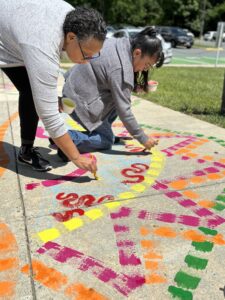 Understanding and Empathy. Listening to others’ stories, truly hearing and seeing them without judgment, is crucial. Right now, we live in a time when a small, powerful percentage of the population is trying to remove our rights and progress as a nation because they fear that a safe place for everyone means they will have fewer freedoms. We may not always know someone else’s experiences, but it is vital to recognize each individual as a person, normalize asking for help without judgment, and foster a supportive community. Remember, we might need assistance one day, hoping for someone to listen and understand. If you find yourself in a situation where you need help, please ask for it. Do not let pride prevent you from reaching out to those willing to listen and support you in your time of need. Seeking help can be a vital step toward moving forward and achieving success in life’s various tasks.
Understanding and Empathy. Listening to others’ stories, truly hearing and seeing them without judgment, is crucial. Right now, we live in a time when a small, powerful percentage of the population is trying to remove our rights and progress as a nation because they fear that a safe place for everyone means they will have fewer freedoms. We may not always know someone else’s experiences, but it is vital to recognize each individual as a person, normalize asking for help without judgment, and foster a supportive community. Remember, we might need assistance one day, hoping for someone to listen and understand. If you find yourself in a situation where you need help, please ask for it. Do not let pride prevent you from reaching out to those willing to listen and support you in your time of need. Seeking help can be a vital step toward moving forward and achieving success in life’s various tasks.
5. What do you hope residents will gain from the mural in terms of climate resilience, and how do you envision it inspiring action or awareness in the community?
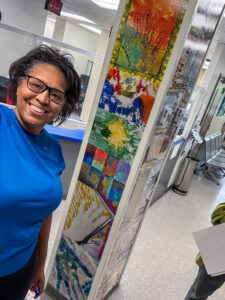
Our Responsibility. This mural challenges us to reflect on our roles in the community and the environment. It urges us to stop the cycle of taking without giving back. By fostering a spirit of empathy and responsibility, primarily through a creative lens, we can create a more resilient and sustainable future for ourselves and the planet. Thank you for taking the time to engage with this mural. I hope the community sees themselves in this display of art, and we can create future projects similar to this in other venues to increase awareness and allow audiences to heal and grow. May it inspire you to listen more deeply, connect more meaningfully, and act more responsibly.
1. Tell us, what is your position at the Department of Environmental Protection.
Doug Weisburger, Senior Planning Specialist, Sustainability Programs, Montgomery County Department of Environmental Protection.
2. Can you tell us what the County’s Climate Action Plan is in a nutshell? And why your department collaborated with the Arts & Humanities Council (AHCMC) on this residency?
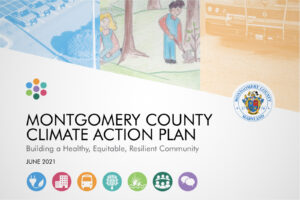 The Climate Action Plan (CAP) is the County’s roadmap to cut greenhouse gas (GHG) emissions 80% by 2027 and 100% by 2035, build community resilience among residents most vulnerable to climate hazards, and advance racial equity.
The Climate Action Plan (CAP) is the County’s roadmap to cut greenhouse gas (GHG) emissions 80% by 2027 and 100% by 2035, build community resilience among residents most vulnerable to climate hazards, and advance racial equity.
Years ago, colleagues working on the CAP realized the power and importance of artists and their ability to stimulate reflection and action on important issues. In fact, one of the 86 actions is: “Engage County Artists through Public Art Installations to Raise Awareness, Discussion, and Action on Climate Change.”
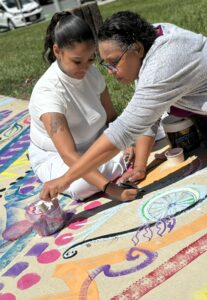 |
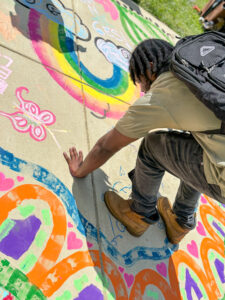 |
Most folks, on some level, understand the need for personal action to reduce GHG emissions, but less is understood about how climate hazards (e.g., more and increasingly intense storms, increased high heat days, etc.) disproportionately and inequitably impact our most vulnerable residents – the latter is the focus of the “Resilience through Art” project.
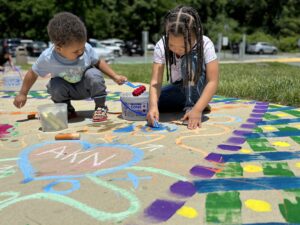
Elbereth, in addition to her role as a social worker in Health and Human Services (HHS), was keenly interested in climate action and serving as a Health and Human Services “Climate Ambassador,” a changemaker within the Department helping to catalyze climate action. She recognized that climate action requires building social support and helping frontline residents deal with increasingly challenging, often deadly, new weather patterns. She sought some way to inject a little hope and healing among residents using services at HHS, many of whom are dealing with physical and emotional trauma. This led us to AHCMC, an organization I’ve worked with previously. We received such a positive and collegial response when we reached out, indicating they could match our investment. That helped me make the case internally to allocate funding for this project.
3. What was your experience collaborating with a local artist to engage your clients in discussions about climate resilience?
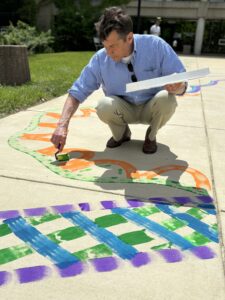
The entire experience was just so humanizing and love-filled. You probably don’t hear government bureaucrats speaking that way, but that’s how I felt! Dinah is such a genuine, authentic, and loving person, and it was wonderful to work with someone whose work is driven by a desire to make the world better. In this case, it was about providing a little more hope to County residents by essentially conveying, through art, that it’s okay to ask for help. And, because she made herself vulnerable and shared difficult times she’d experienced, she created an atmosphere of trust and sharing. It was very moving to hear HHS clients share their difficulties and take a moment out of their challenging day to contribute their individual artwork, which ultimately became part of the collective work you now see. The collaboration with Dinah truly lifted me spiritually.
4. Why do you think it’s important to approach environmental and social justice goals through the lens of a creative practice? How does their intersectionality impact this work?
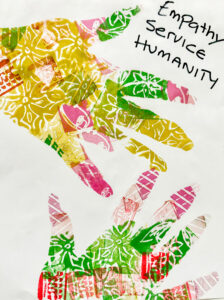 For years, climate practitioners like me tackled climate change in a narrow way, as if it were a math problem and all we had to do was reduce GHG emissions. Of course, that’s fundamentally important, but you can’t talk about climate change without talking about racial equity and social justice. Climate change is upon us, and just like Covid, it magnifies poor health, financial and housing instability, food security, etc., among our most vulnerable residents.
For years, climate practitioners like me tackled climate change in a narrow way, as if it were a math problem and all we had to do was reduce GHG emissions. Of course, that’s fundamentally important, but you can’t talk about climate change without talking about racial equity and social justice. Climate change is upon us, and just like Covid, it magnifies poor health, financial and housing instability, food security, etc., among our most vulnerable residents.
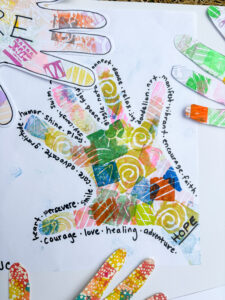 So, for example, those in the lowest income brackets, often Black and Brown community members, might live in basement apartments and be more vulnerable to floods and mold. Or they’re facing an increased “energy burden” because they need to run their air conditioners more to deal with more high-heat days, which, in turn, might cause them to spend less on something as critical as food or something else. No one should face that wrenching choice. In addition, lower-income residents contribute the least to the climate crisis. Therefore, it’s essential we take an intersectional approach to address this set of interrelated challenges.
So, for example, those in the lowest income brackets, often Black and Brown community members, might live in basement apartments and be more vulnerable to floods and mold. Or they’re facing an increased “energy burden” because they need to run their air conditioners more to deal with more high-heat days, which, in turn, might cause them to spend less on something as critical as food or something else. No one should face that wrenching choice. In addition, lower-income residents contribute the least to the climate crisis. Therefore, it’s essential we take an intersectional approach to address this set of interrelated challenges.
Bringing these human issues to the fore is well suited to the creative practice, which moves people emotionally in a way that charts and data cannot.
5. As a public administrator, how do you envision this mural will impact the local community’s understanding of climate resilience, and how does it align with your goals for public engagement on this issue?
This project was focused on giving HHS clients a voice to express their lived experiences – their fears, challenges, hopes- through art and enhancing HHS staff’s understanding of their circumstances so that their needs are better supported and met. In some small way, we’re hoping the project enhances teamwork and goodwill between clients and staff and that this beautiful art, which clients helped to create, engenders some peace during turbulent times.
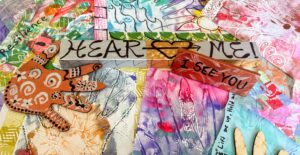
We recognize the residency and mural don’t resolve the crises some residents are facing, but hopefully, they stimulate conversations about the intersectionality of big societal issues and the need for enhanced, cross-sectoral collaboration.
6. What advice would you give to other county agencies interested in collaborating with artists and AHCMC?
Carve out some funds in your budget to partner with AHCMC, engage local artists, and humanize your work! If you have a basic idea about what you want to accomplish and why, reach out to discuss. They are great listeners and will offer ideas you hadn’t considered that will improve your idea. Be open to collaboration and workshopping your concept in a co-creation process. They are generous with their time and ideas!
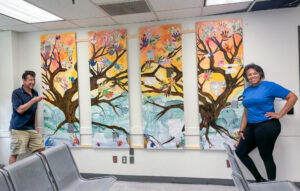
1. Tell us, what is your position at the Department of Health and Human Services (DHHS)?
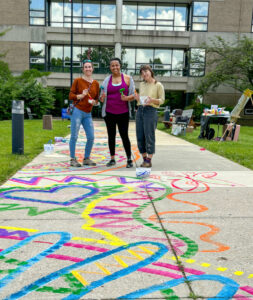
I am a Lead Social Worker III within HHS, Housing Stabilization, Services to End & Prevent Homelessness (SEPH). I was inspired by the DEP’s grassroots efforts during 2022 to elicit Climate Ambassadors throughout all program areas. I engaged a small cohort of colleagues to collect ideas on how to make small, effective connections to our work intersecting with Climate Change, paying particular attention to current racial disparities and inequities in the communities we serve that are most vulnerable to climate hazards. Through my cohort’s encouragement, I sought to improve the overall experience of individuals and families seeking emergency services in our lobby, with a hands-on beautification goal that would leave a legacy of interconnectedness and tell the story of resilience.
2. Can you tell us what the County’s Climate Action Plan is in a nutshell? And why your department collaborated with the Arts & Humanities Council (AHCMC) on this residency?
The County was/is seeking a whole-of-government approach to address the climate crisis. Much like our emphasis on racial equity, the County intends to embed climate change work across all departments and agencies. Ambassadors and their Climate Teams are responsible for mobilizing staff within their departments/agencies to implement and evolve the County’s Climate Action Plan. It was easy to rapidly identify intersections in our work that we could act on, such as the beautification goals; however we needed external competency backing/leadership to see it through. This is where Doug Weisburger- Senior Planning Specialist, Sustainability Programs, Montgomery County Department of Environmental Protection (DEP)- and the Arts and Humanities Council (AHCMC) really shined and gave breath to the prospect.
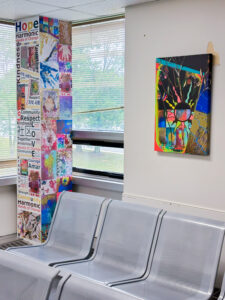
Whilst our group offered representation across several MCG locations, there is a great emphasis on 1301 Piccard as “the Hub” for so many programs and public interfaces. From social services, child welfare, domestic violence, the crisis center, and the list goes on. 1301 Piccard also stood out for its ability to support more staff in addition to clients when determining locations best suited to improve morale, retention, and information sharing with the community.
In line with the top ten climate action plans set forth by the MCG Department of Environmental Protection, we respectfully requested support for: Environmentally themed Artistry/Murals throughout the buildings (as many sites as we have commissioners to produce and repeat them), designed and implemented by community members. The current aesthetics of our most visited site are sterile and unfriendly, missing opportunities to inspire and promote a positive relationship between the community and its provider of services. We see this as a great source of impact to inform and elicit a greater sense of connection with clients, staff, and the environment.
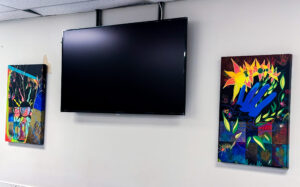 |
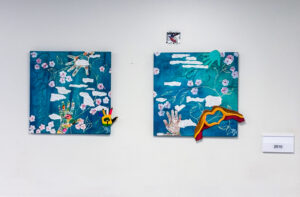 |
Harmonic Hands for Change by Artist Dinah Myers Schroeder and Residents of Montgomery County, MD
DEP utilized their connection to AHCMC to support the design and funding of the entire project. They were instrumental in assuring we did things correctly by supporting the scope of work narrative and marketing the call to local and amateur artists. They took our ideas to the next level, suggesting an artist residency concept to support clients and staff in curating artworks and then culminating them into a larger body of work.
3. What was your experience collaborating with a local artist to engage your clients in discussions about climate resilience?
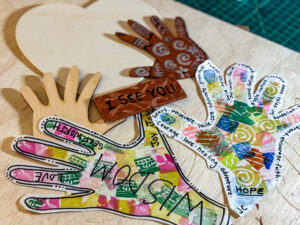 Dinah was “the one” from the start. Her submission during the Call for Artists really stood out, intersecting her personal and professional knowledge in all aspects of the projects’ intentions. In short, the goal was to strengthen the ties of community in the face of increasing climate hazards by sparking reflection on issues such as community resilience, supporting one another and facilitating healing in difficult times, promoting an environmental ethic, and nourishing our connection to the natural world to improve our physical and emotional health.
Dinah was “the one” from the start. Her submission during the Call for Artists really stood out, intersecting her personal and professional knowledge in all aspects of the projects’ intentions. In short, the goal was to strengthen the ties of community in the face of increasing climate hazards by sparking reflection on issues such as community resilience, supporting one another and facilitating healing in difficult times, promoting an environmental ethic, and nourishing our connection to the natural world to improve our physical and emotional health.
Dinah empowered participants by allowing herself to be vulnerable and share her childhood story. This ignited others’ bravery to write and share their narratives as well, from traumas to triumphs.
I cannot thank Dinah, the DEP, and AHCMC enough for the sweat equity that will leave a lasting legacy on those who come here for help.
4. Why do you think it’s important to approach environmental and social justice goals through the lens of a creative practice? How does their intersectionality impact this work?
- Positive marketing/engagement opportunities for employees and clients in line with the climate action plan to make the connections between HHS’ mission and climate change more explicit.
- Supports environmental impact education to residents, improves employee relations, retention, morale, and leads community initiatives.
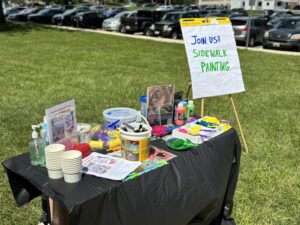 |
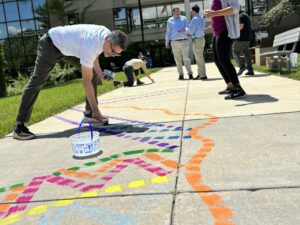 |
- Environmentally themed concept of beautifying the space AND connecting community (clients and staff) to mental health, self-care, resiliency, and supportive services within county govt. walls.
- Resident Artist’s Commission maximized the cost and expanded the impact of this project across staff and constituents served by this location. It also had a positive trickle effect, including staff and community members invited from other social services locations to participate.
5. As a public administrator, how do you envision this mural will impact the local community’s understanding of climate resilience, and how does it align with your goals for public engagement on this issue?
Many residents who come to us for services generally distrust the government. This opportunity allowed us to acknowledge our mutual humanity and fellowship with our neighbors. Each participant could step out of their typical role (professional, client, etc.) and be a peer.
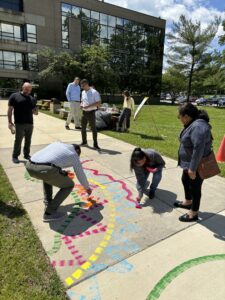 |
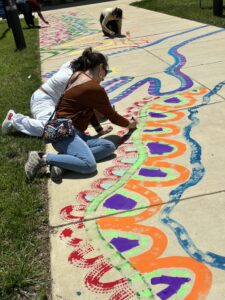 |
We laughed, wrote down our stories, and cried together. Each event was an incredibly moving experience. Everyone who came extended the experience beyond the workshop time frames; they clearly wanted to stay and commune as long as possible. It was a bubble of supportive energy, a shared experience of hardship and survival.
6. What advice would you give to other county agencies interested in collaborating with artists and AHCMC?
They better know Doug. 😉 Honestly, this project was far outside my scope of competence and confidence. Our division had limited funding and did not know how to support my vision. By networking outside my program area and persisting through numerous meetings across MCG with various stakeholders and senior leadership, through patience and methodical process, and with a lot of dedication, it was done in about two years.

